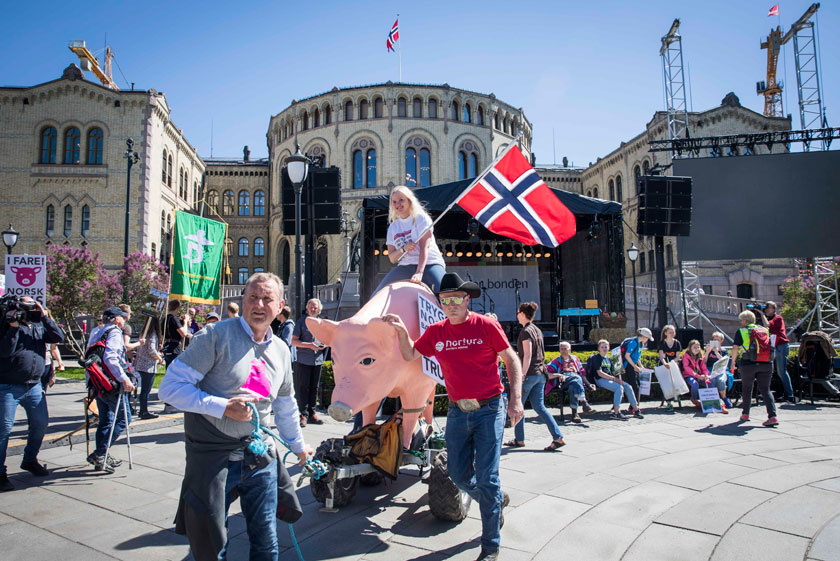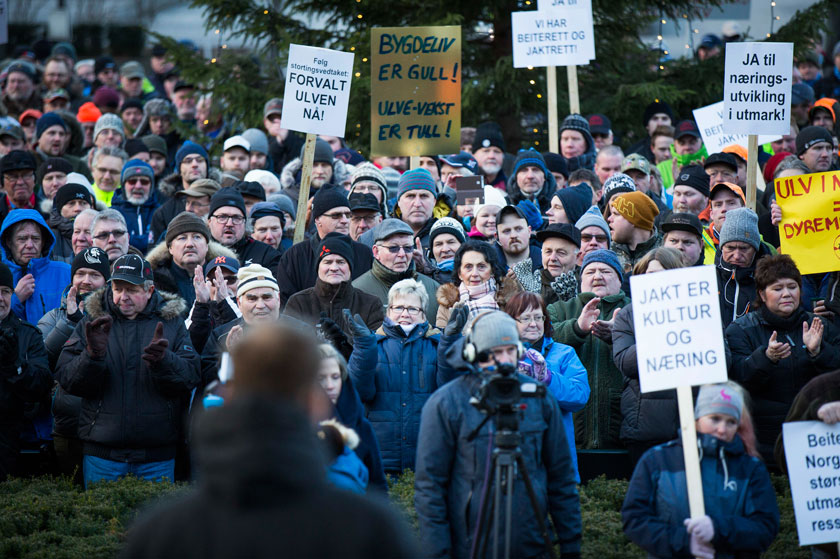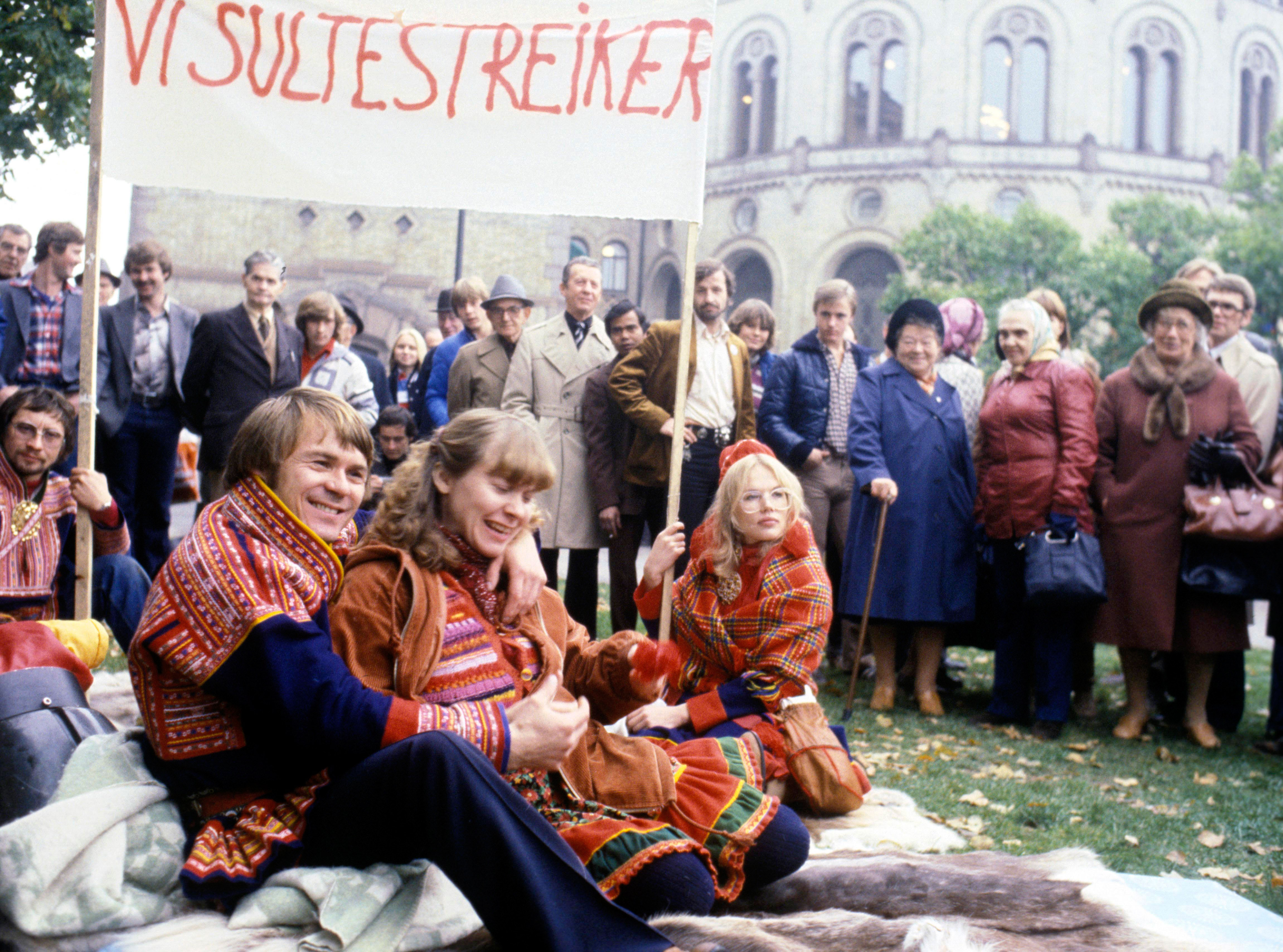
Displeased farmers gathered in front of the Storting on Tuesday 23rd May to protest against the 2017 agricultural settlement. Photo: Storting
From marshland to soapbox
On Tuesday 23rd May the tractors rolled into town as farmers from all over the country gathered in Eidsvolls plass to demonstrate against the Government’s proposed agricultural settlement. Every year, around 300 demonstrations are held in the square that was once a bog.
Different groups gather here on an almost daily basis to draw the attention of Norway’s national politicians to the issues that concern them.
Express yourself
Eidsvolls plass is situated directly in front of the Storting, flanked by two of Oslo’s most famous streets, Karl Johans gate and Stortingsgata. What was once marshland has been turned into an attractive, grass-covered square. Here, statues of some of Norway’s most important political figures, Johan Sverdrup, Carl Joachim Hambro and Christian Fredrik VII, keep their eye on the people of Oslo as they take a break from the hustle and bustle of the city.
Yet Eidsvolls plass is more than simply a recreational area in the heart of the city. It is also a place where the population at large can express their views. Anyone is at liberty to apply to hold a gathering or demonstration in front of the Storting, with well over 300 such events taking place annually.
Dissatisfaction with the resolution on wolves
Many probably remember the demonstration on 4th January this year when nearly two thousand protesters converged on Eidsvolls plass to highlight their dissatisfaction with the Government's wolf resolution.

Opponents of the resolution on wolves demonstrated at Eidsvolls plass on 4th January 2017. Photo: Storting.
18 full buses arrived from the county of Hedmark, but many also came by car, train and air from the rest of the country to make themselves heard in front of the Storting.
Hedmark's department of Norway's Hunting and Fishing Federation explained that Eidsvolls plass is a natural place to hold such a demonstration, since the Storting was involved in the decision. It was also convenient considering that the barriers around Oslo made it difficult to demonstrate outside the Government's premises. The purpose of the demonstration was to be both seen and heard.
Freedom of expression in the Constitution
Article 100 of the Constitution states that "There shall be freedom of expression [...]. Everyone shall be free to speak their mind frankly on the administration of the State and on any other subject whatsoever." One of many ways to make use of this right is to demonstrate in Eidsvolls plass.
In many ways it is not dissimilar to the famous Speaker's Corner in London's Hyde Park, which is a prominent example of freedom of expression in practice. Anyone can show up unannounced and discuss a topic of their choice, to the enjoyment or frustration of their audience. Whoever speaks must also expect to receive the views of the crowd in return.
It is hard to say when the demonstrations in Eidsvolls plass first began. Prior to this, Akersgata at the rear of the building was used for demonstrations because it was where the politicians entered the Storting. Karl Johans gate was also used, since it was possible for the politicians to follow the demonstrations from their vantage point in the Eidsvoll Gallery, which overlooks Karl Johan. This was later stopped by the police due to traffic considerations.
The post-war years
Archive photos show that there have been regular demonstrations in Eidsvolls plass since the Second World War. There are several particularly well known events, including the anti-road tax demonstrations of the 1950s, the demonstrations against NATO at the end of the same decade, the anti-Vietnam demonstrations in 1968, and the so-called Alta conflict in 1979.

Demonstration against the development of the Alta-Kautokeino watercourse on 9th October 1979. Sami protesters from Masi set up camp outside the Storting and went on hunger strike to protest against plans to construct the Alta-Kautokeino power plant. Photo: Erik Thorberg/NTB Scanpix.
Presidium proposes a ban
At one time, in 1952 to be precise, the subject of banning demonstrations from outside the Storting for security reasons was debated. At the end of the parliamentary sitting of 22nd October, the President asked the assembly whether any Member wished to take the floor before the sitting was adjourned. A matter that had been under discussion in the Presidium was raised. A woman had been badly injured by a loose railing during a demonstration, leading the Presidium to propose banning demonstrations in Eidsvolls plass.
Several of the Members took the floor. They spoke in favour of the need to safeguard freedom of speech, adding that matters of security should be left to the police rather than the Storting to decide.
“In my opinion, the right to demonstrate is such a fundamental aspect of a democratic society that we must tread extremely carefully before doing anything that could be viewed as an encroachment on this, for whatever reason. It is something that cannot be severed from a democracy. Basically, it’s the only way for the man in the street to express his views – except for the one day every four years,” Jon Leirfall of the Farmers’ Party (now Centre Party) said.
“I believe that having the easy opportunity to express one’s dissatisfaction with the Storting, or even one’s enthusiasm for the Storting, granted that this kind of impulse occurs considerably less commonly, is a basic human right,” said the Conservative Party’s John Lyng.
The point was also made that if Eidsvolls plass were to be used for demonstrations, it should be specially adapted with that aim in mind.
“I agree that if these measures would actually result in restricting freedom of speech in our country, the Storting should not hesitate to bear the extra expenses associated with overhauling Løvebakken right now. If not, however, we should be able to wait for a couple more years,” underlined Trond Hegna of the Labour Party.
In short, there was broad agreement between the parties in the Chamber that the Presidium should reconsider its decision, so that freedom of expression in Eidsvolls plass could be guaranteed.
And this explains why the demonstrations in Eidsvolls plass have taken place ever since, and why last week the square was full of farmers and tractors.
Last updated: 29.05.2017 08:58